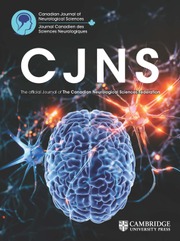A 35-year-old female with right ptosis and right facial and left limb paraesthesia visited our emergency room. Initial diffusion-weighted MRI revealed right lateral medullary infarct. Digital subtraction angiography (DSA) demonstrated dissection of pearl-and-string type involving a segment including a posterior inferior cerebellar artery (PICA) origin of the right distal vertebral artery. The natural course of unruptured intracranial vertebral artery dissection had been reported to be benign, with a high chance of spontaneous healing.Reference Mokri, Houser, Sandok and Piepgras 1 , Reference Arnold, Bousser, Fahrni, Fischer, Georgiadis, Gandjour and Benninger 2 However, in this patient the dissection changed to saccular aneurysm type on follow-up contrast-enhanced MRI and DSA after nine months. The diameter of the dilated segment was also increased from 4 to 8 mm. Furthermore, wall enhancement was noted in the dissected arterial wall. The wall enhancement in the cervical artery dissection has been reported to be suggestive of inflammation and mostly resolve within six months.Reference Pfefferkorn, Saam, Rominger, Habs, Gerdes and Schmidt 3 Vessel wall enhancement can also be seen in such other arterial diseases as atherosclerosis, moyamoya disease and vasculitis.Reference Choi, Jung and Lee 4 Nevertheless, taking account of the change in geometry and the persistent vessel wall enhancement together, we concluded that the dissection had progressed despite conservative treatment. Thus, stent-assisted coil embolization was performed in the patient without complication.
Disclosures
SL, HSC, JJ, SLJ, KJA, BK, JK, and YSS hereby declare that they have no conflicts of interest to disclose.

Fig. 1 Initial MRI and DSA. Diffusion-weighted image (A) shows hyperintensity in right lateral medulla, suggestive of acute infarction. Magnetic resonance angiography (MRA) source image (B) and three-dimension (3D) rotational reconstructed image of DSA (C) show focal stenosis and fusiform dilatation (arrow) at distal vertebral artery, proximally to origin of PICA (arrowhead).

Fig. 2 Six-month follow-up MRI and DSA of the same patient. 3D-SPACE (A) shows wall enhancement (arrow) of dissecting aneurysm. MRA source image (B) and 3D-rotational reconstructed image of DSA (C) show interval change of saccular aneurysm formation at distal vertebral artery (arrow), proximally to PICA origin (arrowhead).




